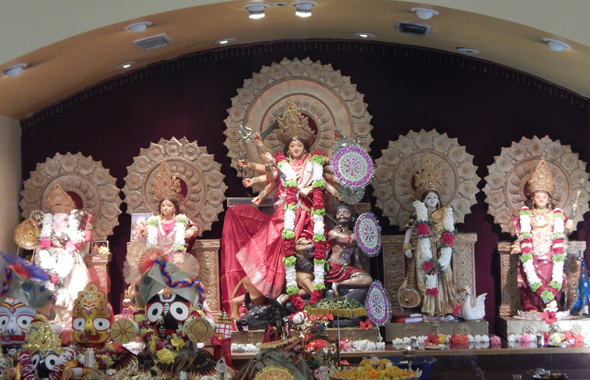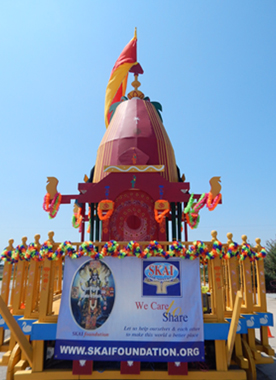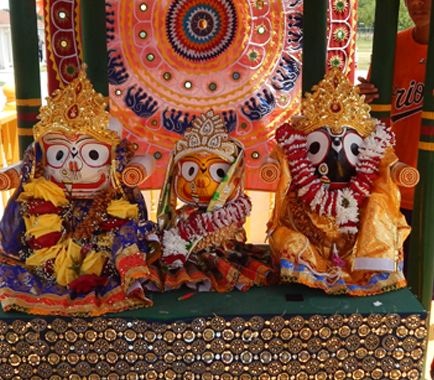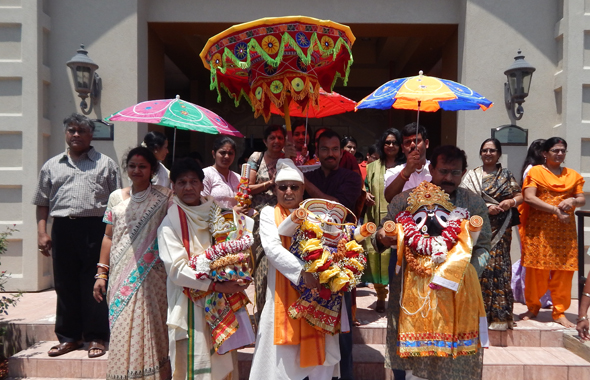Ratha Yatra at Durga Bari: Southern Sun Can’t Stop an Eastern Tradition
By Parth Dwivedi
HOUSTON: The Ratha Yatra, or Chariot Festival, was celebrated at the Houston Durga Bari in Houston on Saturday, July 13. The event was organized to bring the festivities of the original Ratha Yatra held in Puri, Orissa every year closer to home. Traditionally, the festival is celebrated on the second day of the waxing cycle of the moon in the third lunar month, Ashad Maas.
In Puri, the festival is a momentous event and is celebrated with great fervor. It commemorates a journey undertaken by Lord Jagannath to his maternal aunt’s house, the Gundicha Temple, on his birthday. Along with him, Subhadra and Balabhadra are also honored in the trip.
Transporting the deities from their homes into their rathas is called the Pohandi, and is considered an important part of the Ratha Yatra, as even the Sudarshana Chakra is taken out of the Jagannath Temple to go with the deities.
In Puri, the return trip would also carry much significance, as a seven-day stop to the Mausi Ma Temple is made along with way. During this stop, Poda Pithas would be made and shared, as they are said to be Lord Jagannath’s favorite food.
Traditionally, a ceremonial king is also chosen, whose role is to sweep the ground in front of the ratha, a symbolic undertaking performed by coordinator, Dr. Raghu Dass this year. Dr. Dass described the main points of the Ratha Yatra to be “divinity and humanity,” beaming with happiness at the growing popularity of the festival as he spoke about the other Ratha Yatras in the Greater Houston Area, “This festival is a great way for people of all backgrounds to pull together.”
Durga Bari and SKAI Foundation collaborated to organize and promote this year’s Ratha Yatra. Partha Mohanty, coordinator, explained that since the Jagannath Temple is traditionally only accessible to upper-caste Hindus, the Ratha Yatra carries significance in addition to the belief that seeing Lord Jagannath bestows good luck and auspices upon the viewer—the festival also represents a chance for interfaith dialogue and tolerance, since Lord Jagannath is readily accessible by those of any faith, caste, or creed when he leaves his temple. Anyone can actually touch the murti of Lord Jagannath, thus making the opportunity of interactive worship a very personal event for those who partake.
The day started with a pooja at nine a.m. At noon the Aarti was sung, followed by the long-awaited Pohandi. 86-degree heat did not hinder the enthusiastic devotees as the pulling of the ratha began smoothly. Prasad and a finely catered lunch were a welcome follow-up to the morning portion of the two-part event.
Rae Kim, a 19-year-old Korean American, made the trip down from The Woodlands, saying that the literal representation of Lord Jagannath’s story made the message easier to understand for an outsider. For further information visit skaifoundation.org.




